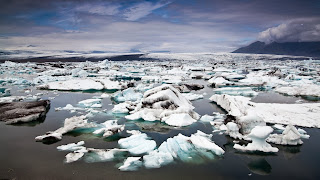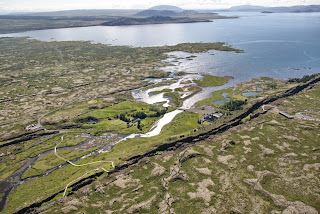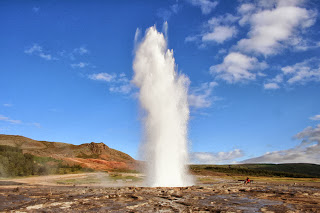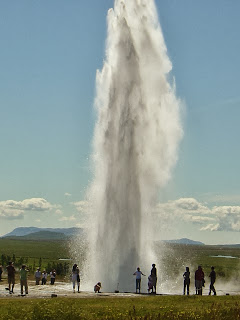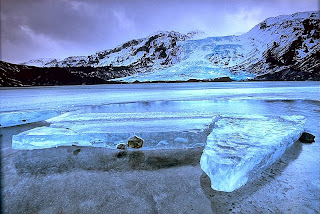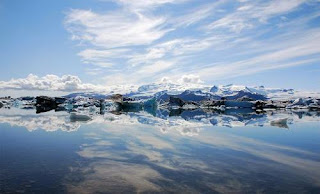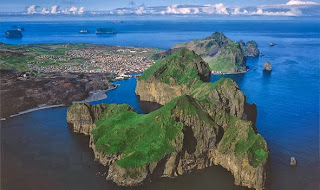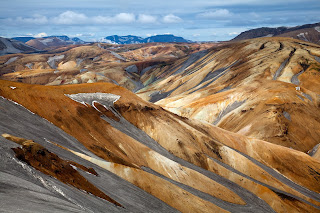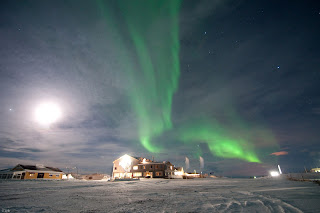Nowhere on earth is the junction between the European and American tectonic plates in the Earth’s crust as clear as on the Reykjanes peninsula in the southwest, and at Þingvellir: the plates diverge here by as much as 2 cm per year. But the gap is constantly being filled, as volcanoes have been erupting regularly throughout Iceland’s history.
The boundaries of this area are drawn at the glacial lagoon Jokulsarlon in the East, and fishing and ferry town Thorlakshofn in the West. Towns, villages, places of interest and recreation are mentioned above and below.
The South is both densely and sparsely populated. Between the town Hofn and the river Markarfljot are vast alluvial or outwash plains, lava fields and narrow strips of lowlands, which limit agricultural activities, but the western part contains the largest and fertile agricultural area of the country and a few townships.
The landscapes of the lowland and highland areas contain many of the most interesting and beautiful spots of the country. The southern central highlands boast of the largest glaciers, most active and largest volcanoes and eruptive fissures, rhyolite intrusions and hyaloclastite mountains. There are many very active geothermal areas in the mountains and lowlands between the middle of the area all the way to the western boundaries. One of the two main seismic areas of the country streches from Mt Hekla across town Hveragerdi to the end of the southwest peninsula Reykjanes.
Must do and see in South Iceland
1. Thingvellir National Park
Þingvellir (Icelandic "Þing": parliament, "vellir": plains) is a place in the southwest of Iceland near the peninsula of Reykjanes and the Hengill volcanic area.
It is famous for two reasons:
a) As one of the most important places in Icelandic history. In the year 930 the Alþingi, one of the oldest parliamentary institutions of the world, was founded. The Alþingi met yearly, where the Lawspeaker recited the law to all of the gathered people and decided disputes as well. In the year 999 or 1000 the Lawspeaker Þorgeir Ljósvetningagoði made Christianity the official religion of Iceland. After the conversion it is said that, upon returning from the Alþingi, Þorgeir then threw his statues of the old Norse gods into the waterfall that is now named Goðafoss ("Waterfall of the Gods"). At this historical place, the independence of the Republic of Iceland was proclaimed on June 17, 1944.
b) As a national park (since 1928) because of the special tectonic and volcanic environment. The continental drift can be clearly seen in the cracks or faults which are traversing the region, the biggest one, Almannagjá, being a veritable canyon. This causes also the often measurable earthquakes in the area. Þingvellir is situated on the northern shore of Þingvallavatn, the biggest lake of Iceland. The river Öxará traverses the national park and is forming a waterfall at the Almannagjá, called Öxaráfoss Together with the waterfall Gullfoss and the geysirs of Haukadalur, Þingvellir is part of the most famous sights of Iceland, the Golden Circle.
Þingvellir is a designated UNESCO World Heritag Site
Thingvellir, 50 km (31 miles) to the east of Reykjavík, is the national shrine of Iceland. Icelands most historic site, and one of its most beautiful places, it is also part of The Golden Circle tour. The oldest existing parliament in the world first met here in AD930. The Alþing met here every year to enact laws, including the law passed in AD1000 to introduce Christianity into the island. It has always been the focal point for the country, and whenever a major event is to be celebrated, thousands of people come here. At the celebration of the 1,100th anniversary of the first settlement in 1974, more than 60,000 people packed into Thingvellir.
Nearby Lögberg is the cliff overlooking the place where the Alþing (assembly) met, and speakers stood to address the gatherings from this point. Nearby is Drekkingarhylur (The Drowning Pool), where mothers of illegitimate children were drowned. It is sited in the river Öxará in Almannagjá, a lava gorge, which with the Öxarárfoss waterfall, is an impressive sight.
Peningagjá (The Money Chasm) is a deep fissure filled with crystal clear spring water; people throw coins into it from the bridge that lies across. The coins give off strange reflections as they drop through the water, it is said that if you can follow the coin all the way down until it comes to rest on the bottom, your wish will come true. Scubadiving and snorkeling in wet suits is becoming increasingly popular here.
The lake is part of the Þingvellir National Park. The volcanic origin of the islands in the lake is clearly visible. The fissures around it - the famous Almannagjá is the biggest of them - indicate that here the tectonic plates of Europe and The Americas are in a conflict. In this lake, the large quantity of sulfur and salt, the lake is extremely light and the water seems to be in less weight than other lakes.
2. Jökulsárlón Glacier lagoon
Check our article about Jökulsárlón Glacier lagoon
The main lagoon measures about 7 square miles (20 km2) and until 1932 was covered in thick glacial ice. Then the glacier started to retreat, and nowadays more than 300 feet (100 m) of ice breaks away each year to reshape the lagoon and fill it with spectacular icebergs.
The lagoon is open to the sea and so contains a mixture of salt and freshwater, giving it a unique blue-green color. There are hundreds of seals here in the winter and the lagoon supports many species of fish including krill, herring, trout and, occasionally, salmon.
3. Gullfoss Waterfall
Gullfoss is actually two separate waterfalls, the upper one has a drop of 11 metres and the lower one 21 metres. The rock of the river bed was formed during an interglacial period.
Water flows over Gullfoss at an average rate of 109 cubic metres per second. The heaviest floods have recorded a flow of 2000 cubic metres per second. During the summer the flow is 130 cubic metres per second, which would take only 3 seconds to fill this building. People were eager to exploit the power potential of Gullfoss and many plans for hydroelectric developments on the river Hvítá have been proposed.
Check the article call "Iceland's favorite Waterfalls"
4. The great Geysir
One of the greatest natural attractions of Iceland and part of the famous "Golden Circle Tour", The Great Geysir, or Stori-Geysir, has been dormant since 1916 when it suddenly ceased to spout. It came to life only once in 1935, and as quickly went back to sleep. Since then its repose has sporadically been disturbed by the dumping of tons of carbolic soap powder into its seething orifice in order to tickle it to spout.
It is not exactly known when Geysir was created. It is believed that it came into existence around the end of the 13th century when a series of strong earthquakes, accompanied by a devastating eruption of Mt. Hekla, hit Haukadalur, the geothermal valley where Geysir is located. What is known is that it spouted regularly every third hour or so up to the beginning of the 19th century and thereafter progressively at much longer intervals until it completely stopped in 1916. Whether its silence is eternal or temporary no one knows. When it was alive and shooting, it could thunderously blast a spectacular jet of superheated water and steam into the air as high as 60 to 80 meters according to different sources. Its opening is 18 meters wide and its chamber 20 meters deep.
One reason for cessation is believed to be the accumulated rocks and foreign objects thrown into it by thousands of tourists throughout the years. Though definitely damaging, this however could not be the only reason for its dormancy. The Great Geysir was among the most notable geysers in the world, such as those in Yellowstone Park, New Zealand and North Iceland. The English word "geyser" is derived from the Icelandic word "geysir" which means gusher. Though the Great Geysir itself is now more or less inactive, the area surrounding it is geothermically very active with many smaller hot springs.
The attraction of the area is now Strokkur (The Churn), another geyser 100 meters south of the Great Geysir, which erupts at regular intervals every 10 minutes or so and its white column of boiling water can reach as high as 30 meters. The whole area is a geothermal park sitting on top of a vast boiling cauldron. Belching sulphurous mud pots of unusual colors, hissing steam vents, hot and cold springs, warm streams, and primitive plants can all be found here.
A short distance away to the west stands the small Laugarfjall Mountain with a panoramic view overlooking the Geysir area. King Christian IX of Denmark visited the area in 1874 and by the foot of the mountain are the rocks where he leaned while his hosts tried to impress and amuse him by boiling eggs in the hot springs. The rocks are now called Konungssteinar ("The King's Stones").
5. Eyjafjallajokull Glacier
Eyjafjallajökull is one of the smaller ice caps of Iceland, situated to the north of Skógar and to the west of Mýrdalsjökull. The ice cap covers the caldera of a volcano with a summit elevation of 1,651 metres (5,417 ft).
It derives its name from the Island Archipelago off the south coast, The Vestman Islands. This mountain massif is actually the result of continuous eruptions during thousands of years and a vast crater on top has probably been active a few times during historic times of this country. The only documented eruptions took place in 920, 1612, which was seen all the way to the northern part of the country, and during the period 1821-23. The latter two eruptions caused at least damage to property by glacier bursts (floods) and ash fall.
The latter caused a three hours’ flood, covering the wide valley floor north of the mountain. Before and around the turn of the last century, an increased earthquake activity and escaping gasses were watched closely. This volcano, and many others, is within the most active 50 miles wide zone of the country.
The volcano has erupted relatively frequently since the last glacial period, most recently in 2010.
The icecap on top is the sixth largest of the country, and is relatively easily accessible from the mountain saddle Fimmvorduhals, the farms Seljavellir and Mork, and from the north at Stakkolt and Langanes. Nowadays it is not considered a great deed or too much of an adventure to conquer the glaciers in specially equipped and modified jeeps or other vehicles.
Two aircraft have crashed on the icecap. In 1952 an American rescue plane, with five on board, went down and only one body was found on location. The other four obviously had survived and walked away, not to be found during the next few years. Twelve years later, another body was found and a wedding ring of another. The glacier tongue delivered the remaining three bodies in the summer of 1966. Scrap and pieces from the plane have been appearing gradually in and by the sides of the glacier. In 1975, an American couple crashed and lost their lives.
6. The Vatnajókull region
In the magnificent nature of the Vatnajokull Region, everyone can find enjoyable recreation. There are options for adventure trips as well as relaxing trips; for summer as well as winter; for children as well as the elderly and everything in between. Tourists in the Vatnajokull Region can choose from a variety of activities, scenic views, historical sites and points of interest.
You can choose from a variety of outdoor activities such as golf, bird watching, fishing, horseback riding, boat tours, kayak tours, mountaineering, trekking, ice climb, glacier walk, kayak tours, boat tours, snowmobile tours, super jeep tours or ATV tours.
Visit the Thorbergur Center of Culture or the Art gallery in Höfn. Take a swim in the geothermal-heated swimming pool in the town of Höfn or relax in the geothermal hot tubs in Hoffell. Here below you can search for options based on type or location.
7. Westman Islands
Westman Islands is one of the best kept secrets in Iceland and you haven't seen Iceland until you have visited Westman Islands. Westman Islands is one of the wonders of nature, surrounded by mountains, islands, volcanoes and seabirds. Westman Islands also has one of the most beautiful and extraordinary 18 hole golf course in the world.
A common mistake that visitors make when coming to Westman Islands is that they stop for one day. We haven't met a tourist yet that didn't want to stay longer so our advise to you is, spend at least two days and then you might be able to experience all the great things about Westman Islands.
The island is surrounded by rocky mountains, volcano and 14 other small islands which are all in different size and shape. In Westman Island you can find one of the most beautiful and extraordinary golf course in the world, if you like golf you can't let this one pass you by. To enjoy what the island has to offer, we recommend that you take a guided tour around the island and you should take the boat tour, that is truly a spectacular experience where you sail around the islands, into caves, by other small islands/skerries and experience the buzzing birdlife that is in Westman Islands and who knows maybe you will see a flock of killer whales swimming by. Furthermore we recommend that you take a hike :) and walk to Skansinn, Eldfell, Hamar or just walk up the next mountain, you can also rent a scooter if you want to cover more ground.
8. Landmannalaugar
The Landmannalaugar area is a popular tourist destination and hiking hub in Iceland's highlands. The area displays a number of unusual geological elements, like the multicolored rhyolite mountains and expansive lava fields, not far from the service center. The many mountains in the surrounding area display a wide spectrum of colors including pink, brown, green, yellow, blue, purple, black, and white. Two of the most popular mountains among hikers are Bláhnjúkur (meaning "blue peak") and Brennisteinsalda (meaning "sulphur wave").
Tourists visit the area from June through late September, after which time the road is closed. A mountain lodge, in operation since 1951, can accommodate 78 people and has basic amenities. It is located centrally near natural geothermal hot springs, also popular with tourists.
Check our article about Landmannalaugar
9. Climbing Hekla
Trip Difficulty 3 out of 5 possible
Mt. Hekla is undeniably Iceland’s most famous mountain. It is the second most active volcano in Iceland and has erupted frequently in historic times. Last eruption occurred in February 2000. The mountain towers over South Iceland at roughly 1500 meters. The height changes due to movements of the earth crusts and seismic movements. For hundreds of years the mountain was believed to be the gateway to hell and no one dared climbing it. Until, Eggert Ólafsson, a famous Icelandic biologist, decided to throw caution to the wind and succeeded in summiting the mountain in the summer of 1750.
Since then hiking to the top of Mt. Hekla has become a popular route. The terrain is rough lava fields and then ice and snow as we get closer to the peak. It usually takes 3-4 hours to get to the top and there you´ll get your reward. The view from the top of Mt. Hekla is wide and beautiful; you can see all of Fjallabak mountains, up to Vatnajökull glacier (Europe’s biggest glacier) not to mention all the evidence of recent and longstanding volcanic activity.
10. Dyrhólaey
Dyrhólaey is located at latitude 63° 27 N and longitude 19° 06 W. The Icelandic name ending on -ey might indicate that it is an island, which it is not; its a promontory, reaching out into the ocean. It is thought to have been created during a submarine volcanic eruption approximately 80 thousand years ago.
The eruption, which formed Dyrhólaey and the pillars around it (originally parts of it), presumably took place in the same way as other submarine and subglacial eruptions. In the beginning, a major tephra eruption took place and later, when the crater reached the surface of the sea, the lava started to flow and thus ensured its existence. Dyrhólaey is a promontory reaching out into the ocean on the south coast of Iceland. It is the southernmost part of the country and is around 120 m high. Off Dyrhólaey, there are rock pillars, that are unique natural formations.
The roaring Atlantic and its foamy waves wash the black sands at the foot of Dyrhólaey. From there you can enjoy the sight of the varied and fantastic scenery of the Mýrdalur valley, fresh green fields and pastures. Above them, moors and tuff mountains of different shapes, and the mountains of the highland pastures, high and awesome, cut by deep ravines and gorges. Behind them, the white glacier reaches a height of almost 1450 m.
To the west the Vestmannaeyjar archipelago is clearly visible, when visibility is good, and also the mountains Eyjafjöll and the glacier Eyjafjallajökull. Not far off the coast to the west of Dyrhólaey is the Kamburinn, much further out and more to the west is the stack Máfadrangur, where the Gannet colonized a few decades ago.
To the south of the promontory is the stack Lundadrangur with a sizable cave, into which you can go by boat, when the weather is nice and the ocean is calm. To the east is the sheer stack Háidrangur (56 m), which the daredevil Eldeyjar-Hjalti was the first human to climb in 1893, as far as we know. The southernmost part of Dyrhólaey reaching into the sea is called Tóin, and there is the famous opening, which gives it its name Portland in English.. The surroundings are all amazingly beautiful and ever-changing from different viewpoints. A very rich birdlife can be enjoyed, and inquisitive seals are seldom far away.
Few places in the country offer better opportunities for enthusiastic birdwatchers than Dyrhólaey. The various species of seabirds are most prominent in the promontory itself, and not least in the stacks. On some days the rock walls of the promontory and the stacks are almost covered with seabirds.
11. Katla Geopark
Katla Geopark includes geological features of global significance. Over 150 volcanic eruptions have been recorded in the area since the 9th century. The eruptions created the landscape and influenced where people settled. Through the centuries, man and nature have affected the region’s history. The area is constantly changing due to the volcanic activity.
A geopark is defined as a territory, which includes a particular geological heritage and a sustainable territorial development strategy to promote development. It must have clearly defined boundaries and sufficient surface area for true territorial economic development.
The Geopark covers about 9% of Iceland, 9542 km2, and follows the borders of three municipalities, Skaftárhreppur, Mýrdalshreppur and Rangárþing eystra. About 2700 people live within the Geopark. GeologyIceland lies astride the Mid-Atlantic Ridge where tectonic plates move apart from each other, causing a rift zone. A mantle plume exists below the country, centred beneath Vatnajökull ice cap. In South Iceland the interaction of the rift zone and the mantle plume results in complex and diverse volcanic activity. Volcanic activity and its widespread effect on the area’s nature and landscape make Katla Geopark very special.
The Geopark is in the most volcanically active area of Iceland, and the volcanic systems at Eyjafjallajökull, Katla, and Grímsvötn are particularly active. The region is characterised by central volcanoes, eruptive craters and fissures, rootless cones, lava fields, table mountains (tuyas), and hyaloclastite ridges which trend SW-NE, like the rift zone.
Ice caps are prominent in the landscape, topping the highest volcanoes. Outlet glaciers and glacial rivers flow from them and glacial landforms, e.g. moraines and ice-dammed lakes, occur in the area. Large floods, usually glacier outbursts associated with subglacial eruptions, have formed outwash plains in the lowlands. The oldest bedrock in the area is about 2.5 million years old, and can be found at the base of Lómagnúpur, an old sea-cliff (671 m). Other interesting features in the Geopark are fossil-bearing xenoliths, and tephra layers which are useful for dating (tephrochronology).
12. Skaftafell National Park
The second national park, Skaftafell, established in 1967 (400-500 square kilometres), contains some of the most precious natural pearls of the country. The rugged landscapes, mountains and glaciers, the flora and the fauna have a magnetic influence on the visitors.
In 1984, it was increased in area (1736 square kilometres) including a considerable part of Glacier Vatnajokull. In November 2004 the area of the park was still increased to 4,807 square kilometres. It now comprises the Laki Area as well as about half of Euorpe's largest icecap, Vatnajokull. There are no roads in the park, but a network of trails offers the opportunity for differently extended hikes. The camping grounds are large but it is difficult to hammer the tent pegs into the gravel surface. Among the services rendered in the park are toilets, washing machines, a restaurant, a small shop and a very interesting Visitors Centre.
The park wardens offer regular guided walking tours and daily bus tours tours from the park to the volcanic Laki area and Jokulsarlon as well as the daily schedule. A comprehensive brochure with maps and hiking trails is available at the Visitors' Centre. The distance from the capital is about 340 km.
Guðrún, February 2015
Iceland24
Best Time to Visit Iceland
Many individuals who want to visit Iceland wonder when the ideal time for them to come to this remarkable country is. This is a tricky question to answer, however, because when you can visit depends on your work schedule and other obligations. Therefore, instead of telling you what your ideal time to visit should be, today we are going to discuss what goes on during the various seasons, so you can know what to expect when coming at certain times.
Experiencing Iceland during the spring
Everyone loves spring because the days become longer and the smells seem to be different around every corner. However, spring in Iceland feels as though it only lasts for five minutes but during its short period it is wonderful. Many tourists come to the country during this season because they are able to do more since they miss the high season prices and the crowds. This means traveling is a breeze, the days are long and bright and the weather is decent.
Experiencing Iceland during the summer
Summer in Iceland comes with pros and cons. Many tourists love the days are longer and that they can experience the midnight sun. There is also the pleasant weather and the lush and green scenery. Summer is also a great time to come to the region since the highland roads reopen during this season. However, you have to remember that since summer is popular, there will be many crowds, the prices will be higher, and it can be hard to find accommodations unless you booked those months in advance.
Visiting during the summer is not recommended for those who like to go with the flow. You have to plan to have a good experience during the summer in Iceland. Iceland is not a deserted place unless you were planning to go to Langanes. However, if you do not want to come when it is colder, be prepared to have to share your experienced with many others, which could be a way to meet new friends.
Experiencing Iceland during autumn
Iceland is a great place to visit during the autumn because the skies are golden, the trees are colorful, and the darkness can be rather cozy. In addition, if you love experiencing crazy storms from indoors Iceland can offer you that too. When tourists come, they enjoy lower prices and fewer crowds, when compared to the summer months. However, the downside is that the weather can change in a split second, which means your travel plans could have to be changed at any time. However, if you follow the weather advice for travelling everything should be fine. We recommend definitely checking out Þingvellir if you decide to come during this season.
Experiencing Iceland during Winter
If you are someone who loves lights, you are sure to love the Northern Lights, which probably inspired your Iceland trip from the beginning. Iceland can offer you the Northern Lights and fresh snow. Then, of course, there is Christmas, which means tons of Christmas lights, mulled wine and Christmas beers.
Many people might not like traveling to Iceland during the winter months because they fear they will become stranded somewhere because of the weather. This would be okay for those who have a lot of time yet for those who have a short time to explore Iceland due to work obligations, your boss may not be happy to hear about a delayed flight countries away. If you are able to come experience Iceland during the winter, it is highly recommended.
Conclusion
As you can see from the different breakdowns of the seasons, Iceland can be a great place to visit during any time of the year. However, before deciding which season you want to come for a visit, make sure you do background research to be aware of the events and tours that will be available. This way you can make sure, you are able to do the things that you had your heart set on. Additionally, keep your budget in mind as well as how long of a period that you have available to explore the country.
Now that you have read this article, seeing when the ideal time to visit Iceland is for you should be easier for you to determine.
Kolla, Iceland24.
© 2015 Iceland24
Experiencing Iceland during the spring
Everyone loves spring because the days become longer and the smells seem to be different around every corner. However, spring in Iceland feels as though it only lasts for five minutes but during its short period it is wonderful. Many tourists come to the country during this season because they are able to do more since they miss the high season prices and the crowds. This means traveling is a breeze, the days are long and bright and the weather is decent.
Experiencing Iceland during the summer
Summer in Iceland comes with pros and cons. Many tourists love the days are longer and that they can experience the midnight sun. There is also the pleasant weather and the lush and green scenery. Summer is also a great time to come to the region since the highland roads reopen during this season. However, you have to remember that since summer is popular, there will be many crowds, the prices will be higher, and it can be hard to find accommodations unless you booked those months in advance.
Visiting during the summer is not recommended for those who like to go with the flow. You have to plan to have a good experience during the summer in Iceland. Iceland is not a deserted place unless you were planning to go to Langanes. However, if you do not want to come when it is colder, be prepared to have to share your experienced with many others, which could be a way to meet new friends.
Experiencing Iceland during autumn
Iceland is a great place to visit during the autumn because the skies are golden, the trees are colorful, and the darkness can be rather cozy. In addition, if you love experiencing crazy storms from indoors Iceland can offer you that too. When tourists come, they enjoy lower prices and fewer crowds, when compared to the summer months. However, the downside is that the weather can change in a split second, which means your travel plans could have to be changed at any time. However, if you follow the weather advice for travelling everything should be fine. We recommend definitely checking out Þingvellir if you decide to come during this season.
Experiencing Iceland during Winter
If you are someone who loves lights, you are sure to love the Northern Lights, which probably inspired your Iceland trip from the beginning. Iceland can offer you the Northern Lights and fresh snow. Then, of course, there is Christmas, which means tons of Christmas lights, mulled wine and Christmas beers.
Many people might not like traveling to Iceland during the winter months because they fear they will become stranded somewhere because of the weather. This would be okay for those who have a lot of time yet for those who have a short time to explore Iceland due to work obligations, your boss may not be happy to hear about a delayed flight countries away. If you are able to come experience Iceland during the winter, it is highly recommended.
Conclusion
As you can see from the different breakdowns of the seasons, Iceland can be a great place to visit during any time of the year. However, before deciding which season you want to come for a visit, make sure you do background research to be aware of the events and tours that will be available. This way you can make sure, you are able to do the things that you had your heart set on. Additionally, keep your budget in mind as well as how long of a period that you have available to explore the country.
Now that you have read this article, seeing when the ideal time to visit Iceland is for you should be easier for you to determine.
Kolla, Iceland24.
© 2015 Iceland24
Photography in Iceland - A Snapshot of Nature
You've framed the composition. Jagged volcanic rock formations are silhouetted against the crystal glacier horizon. Looking up from the viewfinder of your SLR, reality is confirmed; you are standing shrouded in the ethereal glow of the emerald and violet Northern Lights.
Snap!
It's little wonder why Iceland is seen as the photographer’s paradise. For the seasoned professional or the so inclined amateur enthusiast, there is no shortage of subject matter. With contrasting landscapes covering the island, each one more breathtaking than the last, Iceland is a photographer’s dream destination; from the charming small town islands of Vestmannaeyjar, to the enchanting scenes of nature at the Golden Waterfalls of Gullfloss, your individual photography fairy-tale awaits.
Iceland itself is a unique mix of cultures and traditions that have been refined by a beautiful, yet demanding, landscape. Those who visit cannot help but want to capture a small piece to take home with them. Even those who aren’t normally ‘shutter bugs’ suddenly find a desire to pick up a telephoto lens, a small pocket digital shooter or even a phone, to capture one of the many scenes that touch their imaginations.
Memories preserved on film serve to awaken the spirit of adventure in every naturalist and call one back to the island’s majestic scenes (even for a second to third visit).
Inspired photographers of all skill levels set out into the wilds of Iceland to capture that perfect shot. Iceland may be small, but it has so much to offer in terms of variety. The unique and simple beauty on the island gives photographers the chance to shoot assorted subjects that are suited to every individual’s photographic flare; scenes of nature, wildlife, culture, midnight sun, Northern Lights… you’ll be sure to find your picturesque opportunities in Iceland!
Some quick facts! Iceland has very few trees, making unimpeded wide shots featuring wild, rocky terrain commonplace. Around 11.5% of the country is covered in glaciers. Amazing glass-like structures protruding from the foreground and cascades of ancient ice slides rolling through the mountains are some of the more remote, yet fantastic scenes on the island nation.
In summertime, specifically in June and July, the island experiences 24 hours of day light. The merging of sunrise and sunset make for some magical images of glaciers, beaches or waterfalls bathed in pink and orange light.
Wildlife
For wildlife photographers, Iceland boasts a rich birdlife. Puffins are exceptionally popular models. Stunning bird cliffs can be found around the country with breathtaking sunsets over the sea in the distance. The Icelandic horses provide a graceful subject, if not a tricky one; better snap fast, those ponies are quick!
Whale watching is a popular attraction that doesn’t disappoint. No need to take long trips out to sea, the huge water-dwelling mammals swim very close to the Icelandic coast. If you feel more like capturing images of domestic animals, there are also plenty of sheep and cows - in fact, the sheep outnumber the people 2 to 1! Of course, Iceland is also famous for Santa’s flying friends. Reindeer herds roam freely in some areas.
Northern lights photography in Iceland
In addition to Iceland’s night life, there are the “night lights”. The Northern Lights are another natural wonder that is unique to regions lying in the Arctic Circle. Streaking the night’s sky with vivid color, the Arora Borealis can best be seen in the winter months away from populated areas.
The sight of the northern lights were considered a sign of something sacred to the Norse people; seeing the breathtaking sight today, it is easy to see why.
Culture
There is no place better for quirky images of culture, food, architecture or people than Reykjavík! It is known for its colorful houses, arts, great nightlife and a personality all of its own. The Icelandic population is a mix of Scandinavian as well as Irish heritage, which is reflected in their food, architecture, and character. Dotted around the coastline of the country are a few towns and numerous small fishing villages. Some are very remote and in idyllic settings. The traditional turf houses are small cottage structures covered with earth and make for a rustic, quaint picture.
Iceland’s individuality, diversity and remoteness are what make it such a desirable destination for the amateur or the professional photographer. From its natural wonders, to its animal life and the people who call it home, this island nation has so much to take in, and so much to capture on film. One thing is for sure, on your next Icelandic adventure, you shouldn’t forget your camera!
Photo tours and photo workshops in Iceland
Iceland24 can get you in touch with the talented Florent Gast (info@landmannalaugartours.com), a fully licensed tour operator in Iceland.
Florent Gast is a fantastic photographer that has years of experience in photographing Icelandic nature and both organizes photo tours and workshops in photography. The workshops are small and personal and include information about long exposure methodology, concepts of landscape photography, visual design and composition, working with filters, post processing for web and prints, basics of time-lapse and more.
All the pictures in this article (and most of the pictures on this website) are taken by Florent, many of them during photo tours, such as this one that appeared recently in The Icelandic Times.
Photography in Iceland
Rachel - Iceland24
July 2014
Snap!
It's little wonder why Iceland is seen as the photographer’s paradise. For the seasoned professional or the so inclined amateur enthusiast, there is no shortage of subject matter. With contrasting landscapes covering the island, each one more breathtaking than the last, Iceland is a photographer’s dream destination; from the charming small town islands of Vestmannaeyjar, to the enchanting scenes of nature at the Golden Waterfalls of Gullfloss, your individual photography fairy-tale awaits.
Iceland itself is a unique mix of cultures and traditions that have been refined by a beautiful, yet demanding, landscape. Those who visit cannot help but want to capture a small piece to take home with them. Even those who aren’t normally ‘shutter bugs’ suddenly find a desire to pick up a telephoto lens, a small pocket digital shooter or even a phone, to capture one of the many scenes that touch their imaginations.
Memories preserved on film serve to awaken the spirit of adventure in every naturalist and call one back to the island’s majestic scenes (even for a second to third visit).
Inspired photographers of all skill levels set out into the wilds of Iceland to capture that perfect shot. Iceland may be small, but it has so much to offer in terms of variety. The unique and simple beauty on the island gives photographers the chance to shoot assorted subjects that are suited to every individual’s photographic flare; scenes of nature, wildlife, culture, midnight sun, Northern Lights… you’ll be sure to find your picturesque opportunities in Iceland!
Some quick facts! Iceland has very few trees, making unimpeded wide shots featuring wild, rocky terrain commonplace. Around 11.5% of the country is covered in glaciers. Amazing glass-like structures protruding from the foreground and cascades of ancient ice slides rolling through the mountains are some of the more remote, yet fantastic scenes on the island nation.
In summertime, specifically in June and July, the island experiences 24 hours of day light. The merging of sunrise and sunset make for some magical images of glaciers, beaches or waterfalls bathed in pink and orange light.
Wildlife
For wildlife photographers, Iceland boasts a rich birdlife. Puffins are exceptionally popular models. Stunning bird cliffs can be found around the country with breathtaking sunsets over the sea in the distance. The Icelandic horses provide a graceful subject, if not a tricky one; better snap fast, those ponies are quick!
Whale watching is a popular attraction that doesn’t disappoint. No need to take long trips out to sea, the huge water-dwelling mammals swim very close to the Icelandic coast. If you feel more like capturing images of domestic animals, there are also plenty of sheep and cows - in fact, the sheep outnumber the people 2 to 1! Of course, Iceland is also famous for Santa’s flying friends. Reindeer herds roam freely in some areas.
Northern lights photography in Iceland
In addition to Iceland’s night life, there are the “night lights”. The Northern Lights are another natural wonder that is unique to regions lying in the Arctic Circle. Streaking the night’s sky with vivid color, the Arora Borealis can best be seen in the winter months away from populated areas.
The sight of the northern lights were considered a sign of something sacred to the Norse people; seeing the breathtaking sight today, it is easy to see why.
Culture
There is no place better for quirky images of culture, food, architecture or people than Reykjavík! It is known for its colorful houses, arts, great nightlife and a personality all of its own. The Icelandic population is a mix of Scandinavian as well as Irish heritage, which is reflected in their food, architecture, and character. Dotted around the coastline of the country are a few towns and numerous small fishing villages. Some are very remote and in idyllic settings. The traditional turf houses are small cottage structures covered with earth and make for a rustic, quaint picture.
Photo tours and photo workshops in Iceland
Iceland24 can get you in touch with the talented Florent Gast (info@landmannalaugartours.com), a fully licensed tour operator in Iceland.
Florent Gast is a fantastic photographer that has years of experience in photographing Icelandic nature and both organizes photo tours and workshops in photography. The workshops are small and personal and include information about long exposure methodology, concepts of landscape photography, visual design and composition, working with filters, post processing for web and prints, basics of time-lapse and more.
All the pictures in this article (and most of the pictures on this website) are taken by Florent, many of them during photo tours, such as this one that appeared recently in The Icelandic Times.
Photography in Iceland
Rachel - Iceland24
July 2014
Top 20 Things to Do in Lake Mývatn - Trip to Mývatn
Mývatn offers a unique natural environment. With large contrasts and small distances you can experience the most and the best that Iceland has to offer. Large open spaces with roads and walkways lead travellers to interesting locations, were volcanic eruptions have played a crucial role in the formation of the landscape.
Whether the plan is to enjoy the landscape, examine unique natural phenomena or take a closer look at the plant and bird life, Mývatn has it all. Furthermore the area offers a variety of services in accommodation, food and entertainment, based on years of experience and knowledge. A large number of travellers visit Mývatn in the summer, but many believe the lake and its surroundings to be no less impressive in the wintertime.
The lake was created by a large basaltic lava eruption 2300 years ago, and the surrounding landscape is dominated by volcanic landforms, including lava pillars and rootless vents (pseudocraters). The effluent river Laxá is known for its rich fishing for Brown Trout and Atlantic Salmon. The name of the lake (Icelandic mý ("midge") and vatn ("lake"); the lake of midges) comes from the huge numbers of flies (midges) to be found there in the summer.
Must do
-Drive or cycle around Lake Mývatn, one of the largest lakes in Iceland, 37km2. Varied bird life, unique nature with landscape being formed by intense volcanic activity. Possible to rent a bike.
-Climb up to the crater Hverfjall. Walk the whole circle around the rim of this beautiful tephra ring which is one of the largest in the world.
-Taste the traditional “Hverabrauð” with smoked trout. This is dark bread that the locals bake underground in the geothermal heat. Available at most cafe’s and restaurants.
-Take a relaxing bath in the Mývatn Naturebaths and don ́t forget to try out the natural steam bath as well, but steam bathing is an old tradition in the area. The spa is open all year round. Spoil yourself!
Summertime (1. June - 31. August): 09:00 – 24:00
Entry no later than 23:30.
Wintertime (1. September - 31. May): 12:00 – 22:00
Entry no later than 21:30.
More information: http://www.jardbodin.is/en/
-Go birdwatching around the lake and visit Sigurgeir ́s Bird Museum for an interesting showcase and great information on icelandic birds and their habits.
-Take a sightseeing flight from the local airport in Reykjahlíð village. It sure looks different from above, great views over the region.
-Rent a bike and cycle to the Höfði Peninsula. Great view to the lake, rich birdlife, trees and vegetation.There is a hiking path around the peninsula and great view from the top of the hill.
-Get lost in Dimmuborgir lava formations. Great place for hiking, with marked trails that take you around these beautiful natural formations. Beware of the trolls and elves around.
The Dimmuborgir area consist of a massive, collapsed lava tube formed by a lava lake flowing in from a large eruption in the Þrengslaborgir and Lúdentsborgir crater row to the East, about 2300 years ago.
At Dimmuborgir, the lava pooled over a small lake. As the lava flowed across the wet sod, the water of the marsh started to boil, the vapour rising through the lava forming lava pillars from drainpipe size up to several meters in diameter. As the lava continued flowing towards lower ground in the Mývatn area, the top crust collapsed, but the hollow pillars of solidified lava remained. The lava lake must have been at least 10 meters deep, as estimated by the tallest structures still standing.
The lava flow surface remains partly intact around the Dimmuborgir area, so that the Dimmuborgir itself sits below the surrounding surface area. The area is characterised by large hollow cell- or chamber-like structures formed around bubbles of vapour, and some dramatically standing lava pillars. Several of the chambers and pillar bases are large enough to house humans, giving rise to the term "castles" (borgir).
-Explore the pseudocraters at Skútustaðir, interesting crater formations formed in steam explosions when molten lava flowed over wetland.
-Visit the geothermal area Hverir by Námaskarð. High temperature area where you find steaming fumaroles and bubbling mudpools. Watch out it ́s boiling hot!
-Get to know the icelandic horse and it ́s good temper by taking a riding tour through the beautiful district of Lake Myvatn. No riding experience needed.
-Visit the Krafla area, one of Iceland ́s most active volcanic area. Marked hiking trail to Leirhnjúkur, where the lava is still steaming hot since last eruption in 1984.
-Hike the marked trail to the top of Mt. Vindbelgur. Amazing view over the lake, pseudocraters and the Mývatn region from the top.
-Take a day tour to the Askja Caldera and the nature reserve Herðubreiðarlindir. Scenes of unforgettable Icelandic nature and geology. Only accessible by 4x4.
-Experience the Aurora Borealis - Northern lights, during winter time. You can also go on a snowmobile tour or nordic skiing tour on the frozen Lake Mývatn.
-Meet the Icelandic Yule Lads in Dimmuborgir during the month of December. These are the 13 “santa clauses” of Iceland, funny and interesting fellows.
-Dettifoss is a waterfall in Vatnajökull National Park in Northeast Iceland, and is reputed to be the most powerful waterfall in Europe. It is situated on the Jökulsá á Fjöllum river, which flows from the Vatnajökull glacier and collects water from a large area in Northeast Iceland. The falls are 100 metres (330 ft) wide and have a drop of 45 metres (150 ft) down to the Jökulsárgljúfur canyon. It is the largest waterfall in Europe in terms of volume discharge, having an average water flow of 193 m3/s.
-Buy a traditional Icelandic woolen sweater, as a souvenir to take home. Knitted by the local ladies.
-Participate in the Myvatn Marathon held in May every year. One of the best views one can get while running a marathon. The track goes around the lake.
-Explore the beautiful cave Lofthellir, a weird world of ice and darkness. Amazing ice sculptures inside the lava cave. Only accessible on a guided tour and 4x4.
LINKS
Mývatn panoramic virtual tour
http://www.icelandvirtualtour.com/myvatn-skutustadir-pseudocraters.html
Distances:
The lake was created by a large basaltic lava eruption 2300 years ago, and the surrounding landscape is dominated by volcanic landforms, including lava pillars and rootless vents (pseudocraters). The effluent river Laxá is known for its rich fishing for Brown Trout and Atlantic Salmon. The name of the lake (Icelandic mý ("midge") and vatn ("lake"); the lake of midges) comes from the huge numbers of flies (midges) to be found there in the summer.
Must do
-Drive or cycle around Lake Mývatn, one of the largest lakes in Iceland, 37km2. Varied bird life, unique nature with landscape being formed by intense volcanic activity. Possible to rent a bike.
-Climb up to the crater Hverfjall. Walk the whole circle around the rim of this beautiful tephra ring which is one of the largest in the world.
-Taste the traditional “Hverabrauð” with smoked trout. This is dark bread that the locals bake underground in the geothermal heat. Available at most cafe’s and restaurants.
-Take a relaxing bath in the Mývatn Naturebaths and don ́t forget to try out the natural steam bath as well, but steam bathing is an old tradition in the area. The spa is open all year round. Spoil yourself!
Summertime (1. June - 31. August): 09:00 – 24:00
Entry no later than 23:30.
Wintertime (1. September - 31. May): 12:00 – 22:00
Entry no later than 21:30.
More information: http://www.jardbodin.is/en/
-Go birdwatching around the lake and visit Sigurgeir ́s Bird Museum for an interesting showcase and great information on icelandic birds and their habits.
-Take a sightseeing flight from the local airport in Reykjahlíð village. It sure looks different from above, great views over the region.
-Rent a bike and cycle to the Höfði Peninsula. Great view to the lake, rich birdlife, trees and vegetation.There is a hiking path around the peninsula and great view from the top of the hill.
-Get lost in Dimmuborgir lava formations. Great place for hiking, with marked trails that take you around these beautiful natural formations. Beware of the trolls and elves around.
The Dimmuborgir area consist of a massive, collapsed lava tube formed by a lava lake flowing in from a large eruption in the Þrengslaborgir and Lúdentsborgir crater row to the East, about 2300 years ago.
At Dimmuborgir, the lava pooled over a small lake. As the lava flowed across the wet sod, the water of the marsh started to boil, the vapour rising through the lava forming lava pillars from drainpipe size up to several meters in diameter. As the lava continued flowing towards lower ground in the Mývatn area, the top crust collapsed, but the hollow pillars of solidified lava remained. The lava lake must have been at least 10 meters deep, as estimated by the tallest structures still standing.
The lava flow surface remains partly intact around the Dimmuborgir area, so that the Dimmuborgir itself sits below the surrounding surface area. The area is characterised by large hollow cell- or chamber-like structures formed around bubbles of vapour, and some dramatically standing lava pillars. Several of the chambers and pillar bases are large enough to house humans, giving rise to the term "castles" (borgir).
-Explore the pseudocraters at Skútustaðir, interesting crater formations formed in steam explosions when molten lava flowed over wetland.
-Visit the geothermal area Hverir by Námaskarð. High temperature area where you find steaming fumaroles and bubbling mudpools. Watch out it ́s boiling hot!
-Get to know the icelandic horse and it ́s good temper by taking a riding tour through the beautiful district of Lake Myvatn. No riding experience needed.
-Visit the Krafla area, one of Iceland ́s most active volcanic area. Marked hiking trail to Leirhnjúkur, where the lava is still steaming hot since last eruption in 1984.
-Hike the marked trail to the top of Mt. Vindbelgur. Amazing view over the lake, pseudocraters and the Mývatn region from the top.
-Take a day tour to the Askja Caldera and the nature reserve Herðubreiðarlindir. Scenes of unforgettable Icelandic nature and geology. Only accessible by 4x4.
-Experience the Aurora Borealis - Northern lights, during winter time. You can also go on a snowmobile tour or nordic skiing tour on the frozen Lake Mývatn.
-Meet the Icelandic Yule Lads in Dimmuborgir during the month of December. These are the 13 “santa clauses” of Iceland, funny and interesting fellows.
-Dettifoss is a waterfall in Vatnajökull National Park in Northeast Iceland, and is reputed to be the most powerful waterfall in Europe. It is situated on the Jökulsá á Fjöllum river, which flows from the Vatnajökull glacier and collects water from a large area in Northeast Iceland. The falls are 100 metres (330 ft) wide and have a drop of 45 metres (150 ft) down to the Jökulsárgljúfur canyon. It is the largest waterfall in Europe in terms of volume discharge, having an average water flow of 193 m3/s.
-Buy a traditional Icelandic woolen sweater, as a souvenir to take home. Knitted by the local ladies.
-Participate in the Myvatn Marathon held in May every year. One of the best views one can get while running a marathon. The track goes around the lake.
-Explore the beautiful cave Lofthellir, a weird world of ice and darkness. Amazing ice sculptures inside the lava cave. Only accessible on a guided tour and 4x4.
LINKS
Mývatn panoramic virtual tour
http://www.icelandvirtualtour.com/myvatn-skutustadir-pseudocraters.html
HIKING FROM DETTIFOSS TO MÝVATN
Dettifoss – Lake Eilífsvötn (west side) 12-14 km
Eilífsvötn - Krafla ~12 km
Krafla - Reykjahlíð ~13 km
Navigation
The route from Dettifoss to Krafla is not marked and there is no clear path to follow. The hike from Krafla to Reykjahlíð is a marked trail and starts at the car park at Leirhnjúkur. Therefore, during most of the Dettifoss-Mývatn route, hikers need to have good navigation skills.
Hikers need to know how to use a GPS instrument and/or a compass and have a good understanding of maps. There are hills and mountains in the landscape that are helpful for navigation, eg. the mountain Eilífur, which can be easily seen from nearby Dettifoss on a clear day. However, on a foggy day the forms of the landscape cannot be seen and it is easy to lose direction. Those who do not have good navigational skills are recommended not to go this route.
Route landscape
There are no special dangers on the route. The route from Dettifoss to Lake Eilífsvötn goes over a gravel plain, moor and tussocks and is quite easy to pass. From Lake Eilífsvötn, the conditions of the hiking route depends on which direction is chosen. The more west hikers go the more lava and ravines they pass, where special care has to be taken.
Drinking water
Hikers need to carry all beverages for each day of the hike, as there are only three places where there is access to drinking water:
-On the campsite at Dettifoss there is drinking water in containers. Rangers from Vatnajökull National Park fill the containers with fresh water every day. Please use this water as spaerly as possible.
-At Lake Eilífsvötn, both on the west side and east side, are springs and brooks which are safe to drink from.
-At the toilet house at Krafla/Leirhnjúku
Berglind Rós, Iceland24
© 2014 Iceland24, December 2014
Subscribe to:
Posts (Atom)
